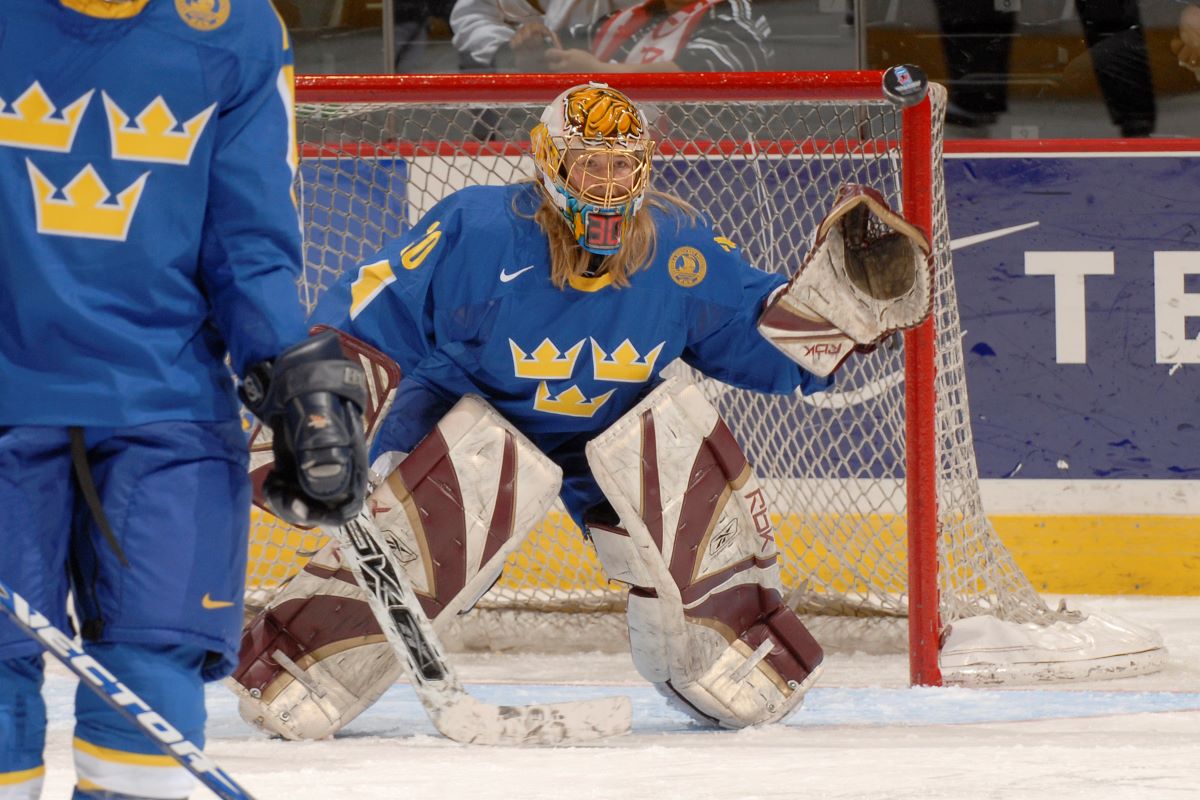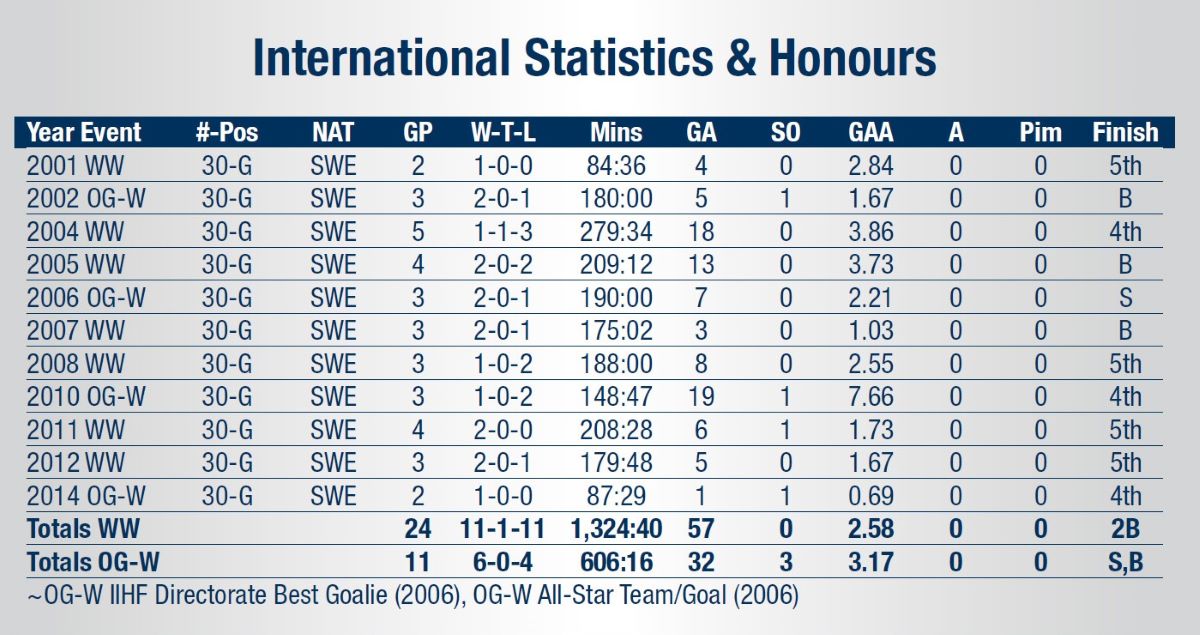photo: © IIHF / HHOF
During the 2025 IIHF Ice Hockey World Championship, short profiles of each of this year's Hall of Fame inductees will appear on IIHF.com in the build-up to the IIHF Hall of Fame weekend (May 24-25). There will be two ceremonies. The Contributors' Awards ceremony takes place on May 24, followed by the IIHF Hall of Fame Induction ceremony on May 25. Both ceremonies will be shown live on the IIHF's YouTube channel and IIHF.TV.
It’s not very often a player will show up to her first year of university hockey already having won an Olympic silver medal and two medals at the Women’s World Championship, but when you start out at age 15, that’s what can happen.
Kim Martin-Hasson was part of a group of players in the early 2000s that first resurrected the Swedish women’s hockey program and then took it to its greatest heights. She played her first games at the Women’s Worlds in 2001, in Minneapolis, as a 15-year-old. The team included up-and-comers Erika Holst and Maria Rooth, as well as veterans Gunilla Andersson and Pernilla Burholm. Although the team finished fifth, and Martin played only two games, this was the start of something significant.
In 2002, in Salt Lake, the Swedes almost didn’t send a team to the Olympics because the program was in disarray and little was expected of it. But Sweden qualified for the bronze-medal game and, backed by Martin, a week shy of her 16th birthday, pulled off a massive upset, beating Finland, 2-1, and claiming bronze. Martin stopped 32 of 33 shots in the game and was heroic in the victory.
At home, Martin was playing in Sweden’s junior leagues, and with the cancellation of the 2003 Women’s Worlds because of SARS it wasn’t until 2004 that she played internationally again. The team finished fourth at those Women’s Worlds, but the team continued to evolve. A year later, Sweden lost a close 4-1 game to the U.S. in the semi-finals and then whipped the Finns, 5-2, to win another bronze. That set the table for an historic Olympics in Turin, in 2006.

In the fall of 2006, Martin joined the University of Minnesota- Duluth, three senior-level medals already on her mantle. The Bulldogs were expecting big things from their Swedish goalie, and she didn’t disappoint. In her first year, she took the Bulldogs to a national championship, shutting out Wisconsin, 4-0, in the deciding game. A year later, she sported an astounding record of 31-4-1.
Martin continued to be the number-one goalie for Damkronor as well. She led them to a third WW bronze in 2007, in what was to be her final medal victory with Sweden. The team was starting to re-build, and the support programs had not developed talents to replace players like Rooth and Holst. In league play, Martin gave the Russian league a try for one season before finishing her career in Linkoping, retiring in 2015.
In all, Martin played in four Olympics and seven Women’s Worlds, 35 games in total, leading Sweden to a position of respectability and winning four medals along the way. Small but agile and fearless, she relied on instinct and anticipation to keep the puck out, and her competitive fire never failed, whether she was playing the Canadians or Americans, competing for a medal, or trying to establish herself at an age when most young players are concerned only with high-school homework and exams.

Kim Martin-Hasson was part of a group of players in the early 2000s that first resurrected the Swedish women’s hockey program and then took it to its greatest heights. She played her first games at the Women’s Worlds in 2001, in Minneapolis, as a 15-year-old. The team included up-and-comers Erika Holst and Maria Rooth, as well as veterans Gunilla Andersson and Pernilla Burholm. Although the team finished fifth, and Martin played only two games, this was the start of something significant.
In 2002, in Salt Lake, the Swedes almost didn’t send a team to the Olympics because the program was in disarray and little was expected of it. But Sweden qualified for the bronze-medal game and, backed by Martin, a week shy of her 16th birthday, pulled off a massive upset, beating Finland, 2-1, and claiming bronze. Martin stopped 32 of 33 shots in the game and was heroic in the victory.
At home, Martin was playing in Sweden’s junior leagues, and with the cancellation of the 2003 Women’s Worlds because of SARS it wasn’t until 2004 that she played internationally again. The team finished fourth at those Women’s Worlds, but the team continued to evolve. A year later, Sweden lost a close 4-1 game to the U.S. in the semi-finals and then whipped the Finns, 5-2, to win another bronze. That set the table for an historic Olympics in Turin, in 2006.

Kim Martin keeps her eyes on the puck. She was only a teenager when she helped Sweden win bronze at the 2002 Olympics and silver in 2006.
Now a mature team with a young core that was also experienced, Sweden pulled off a stunning 3-2 win over the Americans in the semi-finals. They trailed 2-0, but tied the game thanks to two goals from Rooth in the second period, and after a goalless overtime teams went to a penalty-shot shootout. Martin was letter perfect while Pernilla Winberg and Rooth scored for Sweden, sending the team to a most improbable gold-medal game against Canada. It was the first, and still only, women’s Olympics finals that did not feature the two North American teams.In the fall of 2006, Martin joined the University of Minnesota- Duluth, three senior-level medals already on her mantle. The Bulldogs were expecting big things from their Swedish goalie, and she didn’t disappoint. In her first year, she took the Bulldogs to a national championship, shutting out Wisconsin, 4-0, in the deciding game. A year later, she sported an astounding record of 31-4-1.
Martin continued to be the number-one goalie for Damkronor as well. She led them to a third WW bronze in 2007, in what was to be her final medal victory with Sweden. The team was starting to re-build, and the support programs had not developed talents to replace players like Rooth and Holst. In league play, Martin gave the Russian league a try for one season before finishing her career in Linkoping, retiring in 2015.
In all, Martin played in four Olympics and seven Women’s Worlds, 35 games in total, leading Sweden to a position of respectability and winning four medals along the way. Small but agile and fearless, she relied on instinct and anticipation to keep the puck out, and her competitive fire never failed, whether she was playing the Canadians or Americans, competing for a medal, or trying to establish herself at an age when most young players are concerned only with high-school homework and exams.

